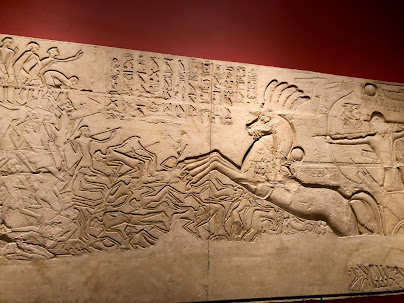This isn’t just a wall—this is how a pharaoh made sure no one forgot who was in charge, especially when the victory was probably a little murkier than the stone lets on. Seti I, charging forward on a chariot, bow drawn, hair (or helmet) feathered, is the picture of dynastic order bearing down on the forces of chaos. The horses rear up, the enemies scatter like a pile of dead spiders, and the message is clear: Egypt wins because Egypt must. If there were a New Kingdom version of Instagram, this relief would be the algorithm-breaking post. Sponsored by Amun. Shot on location in Canaan. Caption: Still undefeated.
But no single artist can claim it—because that wasn’t the point. Egyptian temple art was a state-run operation: dozens of artisans, all anonymous, working in lockstep to deliver royal ideology. This wasn’t creativity in the modern sense. It was disciplined, almost mechanized expression. They didn’t get to choose the scene, the angle, or the message. The pharaoh did. Or more likely, a priest with a checklist did. Still, their skill shows in every muscular line, every enemy bent backward in agony, every detail on the chariot reins. It’s brutal choreography with a chisel. Stylized? Yes. But deliberate and effective—this is storytelling as architecture.
Seti I ruled at a critical moment. He was cleaning up after the Amarna Period, a time when Egypt flirted with monotheism and almost unraveled. His reign was about restoration—of tradition, of power, of Egypt’s dominance abroad. These battle reliefs weren’t just about conquest—they were about signaling continuity. They told every priest, diplomat, and subject: “We’re back. The gods are with us. Don’t get cute.” Whether these campaigns were actually that successful is debatable. But in a world where the divine will and political messaging were the same thing, perception mattered more than body counts.
So what does this relief mean today? It’s not just ancient noise. It’s a lesson in optics. It’s the perfect case study in the performance of power: how leaders manufacture triumph, how institutions reinforce it, and how art—yes, even the sacred kind—is weaponized in the service of myth. And it should make you wonder: what “truth” are we carving into the walls of our own institutions, our platforms, our pitch decks? What’s performance, and what’s real?
If history is written by the victors, but illustrated by the salaried, who’s really shaping the story?
#SetiTheStrategist #StoneColdSpin #KarnakChronicles #ArtAsMessaging #DivineByDesign #EgyptianPsyOps #ReliefAndReputation #TempleOfNarrative #PowerCarvedInStone #ProcurementOfThePast





No comments:
Post a Comment